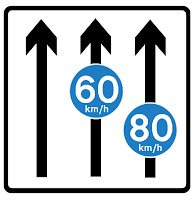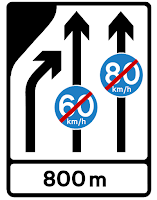These suggestions are described and illustrated in more detail in this article.
Modify the existing sign
The existing crawler lane sign has the text "Crawler lane" in England, and presumably "Crawler lane" as well as its Welsh translation in Wales. This usage of text is avoidable, if something can be represented wholly graphically using internationally recognised symbols, in a language independent manner, then it should be.Existing Crawler Lane signage. "Crawler Lane" requires translation in Wales.
If we are going to keep the "Crawler lane" sign as it is, but make it wholly symbolic, my suggestion is to use a pictogram to mean "Crawler lane", something like the "Slow lorries" going up a hill sign.
Another alternative would be to use the existing lorry symbol, this for me is fine too. But I believe the arrow should go through the lorry to make it clear that the lane is a crawler lane and thus recommended for slow moving lorries.
And as I have shown in my earlier design suggestions in other articles, the arrow should "go through" the symbol as it were (the symbol tells what kind of lane it is, or what restriction is in place for that lane), this is much clearer. This is exactly what is done in countries which have signed the Vienna Convention fully.
A possible updated sign is shown below:
A possible language independent version of the Crawler Lane sign.
Another possible updated sign is shown below, which I would also recommend as an alternative, if the basic design is to be kept as is, but make it language independent and clearer:
Another possible (and recommended) language independent version of the Crawler Lane sign, should the existing design be retained.
Despite having given this suggestion, I would personally recommend or prefer using speed limit by lane, or mass limit by lane instead. These are done by countries which have signed up fully to the Vienna Convention on Road Signs and Signals - including Germany and France. My personal preference is for speed limit by lane, but I would be content with mass limit by lane. The lane or lanes without the speed limit or mass limit would be crawler lanes by implication.
Use speed limit by lane instead (or as an option)
Speed limits by lane are used in Germany. I believe this could be applied for sections of road where crawler lanes exist. One can have speed limits by lane, but only where there are roads with a crawler lane or in general where lorries move slowly up-hill, whether a non-primary route, primary route, or a motorway.Having speed limits by lane instead of a sign saying "Crawler lane" would change the legal meaning, due to actually prohibiting non-compliant vehicles in the non-crawler lanes, I don't see this as a big problem. Nonetheless I would suggest that it is essential to test the roads to see what the minimum speed is on a lane-by-lane basis.
There would need to be one or more signs warning of a speed limit by lane ahead, with or without a lane added.
The example sign below shows a warning of a speed limit by lane 3000m ahead with a lane added, on a primary route:
Minimum speed limit by lane, with lane added, 3000m ahead,
on a non-primary route. The speed limits differ from lane to lane, where applicable
on a non-primary route. The speed limits differ from lane to lane, where applicable
Then once the speed limit by lane starts, a sign needs to inform people of this. Examples are shown below for start of speed limit by lane, with an extra lane added (the crawler lane by implication).
Minimum speed limit by lane, with a (crawler) lane added,
3000m ahead, on a motorway. Note the different speed limits per lane where applicable.
3000m ahead, on a motorway. Note the different speed limits per lane where applicable.
Minimum speed limit by lane, with a (crawler) lane added,
3000m ahead, on a primary route dual carriageway.
Note the different speed limits per lane where applicable.
3000m ahead, on a primary route dual carriageway.
Note the different speed limits per lane where applicable.
Minimum speed limit by lane, with a (crawler) lane added,
3000m ahead, on a primary route dual carriageway.
Note the different speed limits.
3000m ahead, on a primary route dual carriageway.
Note the different speed limits.
Minimum speed limit by lane, with a (crawler) lane added,
3000m ahead, on a non-primary route dual carriageway.
Note the different speed limits.
3000m ahead, on a non-primary route dual carriageway.
Note the different speed limits.
Minimum speed limit by lane, with a (crawler) lane added,
3000m ahead, on a non-primary route single carriageway (hitherto one lane).
The lane without the minimum speed limit is the crawler lane.
3000m ahead, on a non-primary route single carriageway (hitherto one lane).
The lane without the minimum speed limit is the crawler lane.
A speed limit by lane can also exist without a lane needing to be added. But whether or not a lane has been added, the sign shown the speed limits needs to be shown to remind road users that the restrictions are in place.
Minimum speed limit by lane, with all except the left
lane having a minimum speed limit. This is on a motorway.
This would be used both at the start and as a reminder sign in this case.
lane having a minimum speed limit. This is on a motorway.
This would be used both at the start and as a reminder sign in this case.
Minimum speed limit by lane, with a (crawler) lane to the left, on a motorway.
The speed limits are different, this can only be used as a reminder sign.
The speed limits are different, this can only be used as a reminder sign.
Minimum speed limit by lane, with a (crawler) lane to the left, on a primary route.
The speed limits are different, this can only be used as a reminder sign.
The speed limits are different, this can only be used as a reminder sign.
Minimum speed limit by lane, with a (crawler) lane to the left, on a non-primary route.
The speed limits are different, this can only be used as a reminder sign.
The speed limits are different, this can only be used as a reminder sign.
For short distances, a supplementary section saying "↑ 800m ↑" (for example) could be used:
Minimum speed restrictions by lane for 800m
Of course, for the "↑ 800m ↑", the distance would obviously vary depending on the length. I would suggest though that "↑ 800m ↑" or similar should only appear if the distance for which the minimum speed limit by lane applies is very short. It could be that only if the distance is less than or equal to 1000m or 1500m (for example) would "↑ 1500m ↑" appear, if this needs to appear at all. In other words, it is suggested that one needs to define the maximum value for which one needs to show the length of the maximum speed limit.
There could also need to be a warning of an end of minimum speed requirement by lane ahead. The example below is for a non-primary route with a lane drop.
End of minimum speed restrictions by lane,
with a lane merge. This is 800m ahead.
with a lane merge. This is 800m ahead.
Of course, if all lanes other than the crawler lane have the same minimum speed limit (for example these lanes have a minimum speed limit of 100km/h), and there is no lane drop, then one can just have a simple "End of 100km/h speed limit sign" with a supplementary plate simply saying "500m" when the minimum speed limit ends 500m ahead, for example. This would be considerably smaller.
End of 100km/h minimum speed limit 500m ahead.
Then once the restrictions actually end, if all the lanes with speed restrictions had the same speed limit (for example 100km/h in 3 lanes except the crawler lane), and there is no lane drop, then only a single standalone end of speed limit sign is sufficient. Otherwise in the general case, the end of speed limit needs to be reflected in the end of speed limit by lane sign.
End of 100km/h minimum speed limit.
Can also be used if there is no lane drop, and if all lanes
with a minimum speed limit had a 100km/h minimum speed.
Can also be used if there is no lane drop, and if all lanes
with a minimum speed limit had a 100km/h minimum speed.
End of speed limit by lane on a motorway.
In this case, there is a lane drop, but all other lanes
had the same minimum speed limit.
In this case, there is a lane drop, but all other lanes
had the same minimum speed limit.
End of speed limit by lane on a motorway.
In this case, there is a lane drop, and the
minimum speed limit varied from lane to lane.
In this case, there is a lane drop, and the
minimum speed limit varied from lane to lane.
End of speed limit by lane on a primary route.
In this case, there is a lane drop, and the
minimum speed limit varied from lane to lane.
In this case, there is a lane drop, and the
minimum speed limit varied from lane to lane.
End of speed limit by lane on a non-primary route.
In this case, there is a lane drop, and the
minimum speed limit varied from lane to lane.
In this case, there is a lane drop, and the
minimum speed limit varied from lane to lane.
Use mass limit by lane instead (or as an option)
I have seen this type of sign used in France. With this, one can have mass limits by lane, for example 3.5t or 7.5t. I think that mass limit by lane can also be used to have a crawler lane by implication. Once again, although the legal meaning is changed, I don't necessarily see this as a problem.An example which is for non-primary routes is shown below:
Mass limit by lane. All lanes except the
leftmost lanehave a 7.5t mass limit.
leftmost lanehave a 7.5t mass limit.
End of 7.5t mass restriction. Can be used when
all lanes with mass limits had a limit of 7.5t.
all lanes with mass limits had a limit of 7.5t.
























The existing crawler lane sign is fine. Indeed, you could even remove 'Crawler Lane' and it'd still be fairly obvious, in my opinion.
ReplyDeleteNot so sure about having different speed limits for different lanes but if we were to do it, I reckon an overhead gantry with a speed limit over each lane would be much clearer. That's what we do in temorary situations anyway, using those dot matrix signs that most motorways have.
@Gareth Parr - Very good suggestions, I will create a version of the existing crawler lane sign without the wording as soon as I get some spare time. I think you are right, for me I think it would be obvious too even if "Crawler lane" was removed.
ReplyDeleteEven if my personal preference is for speed limits for different lanes, I don't mind if the existing signage is used personally. In fact, it would probably better if it was (especially if the wording was removed) - for cost reasons (introducing all those speed limit by lane signs would cost money, not sure how much) and one less change to worry about.
Overhead gantry with a speed limit over each lane is probably better I agree.
Great post.A good suggestion for that crawler lane sign.That illustration doen't need any welsh translation since it clearly states on the picture itself the route that should have been followed.The speed limits for every lane may be used but making sure that every vehicles shpould have noticed that given signs.Thanks for sharing some thought on this.
ReplyDelete